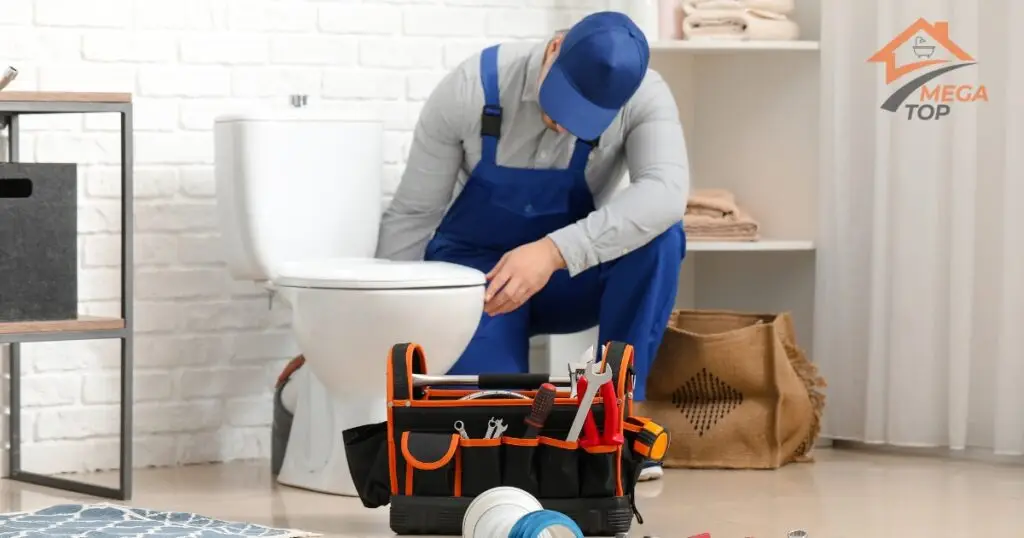Tools and Materials You’ll Need to Install a Toilet
Before starting your toilet installation, it’s essential to gather the right tools and materials. Having everything ready will ensure a smooth and efficient installation process. Here’s what you’ll need:
Tools:
- Adjustable wrench
- Flathead and Phillips screwdrivers
- Putty knife
- Utility knife
- Level
- Bucket or sponge (for water removal)
Materials:
- New toilet
- Toilet flange (if replacing)
- Wax ring
- Toilet bolts and washers
- Flexible water supply line
- Caulk (optional, for sealing the toilet base)
1. Step 1: Turn Off the Water Supply and Drain the Old Toilet
Shutting Off the Water Supply
Start by locating the water shutoff valve, usually located on the wall behind the toilet. Turn the valve clockwise to shut off the water supply completely.
- Flush the toilet: After turning off the water, flush the toilet to remove as much water as possible from the tank and bowl. Use a sponge or towel to soak up any remaining water in the toilet.
Removing the Old Toilet
Once the water is drained, you can begin removing the old toilet.
- Disconnect the water supply line: Use an adjustable wrench to loosen the nut connecting the water supply line to the bottom of the toilet tank.
- Remove the toilet bolts: Unscrew the bolts at the base of the toilet, which secure it to the floor.
- Lift the toilet: Carefully rock the toilet back and forth to break the wax seal, then lift the toilet off the flange. Have a towel or bucket ready to catch any remaining water from the trap.
How to Dispose of the Old Toilet Properly
Once removed, you’ll need to dispose of the old toilet. Check local regulations for waste disposal, as some areas require you to bring old fixtures to a recycling center.
2. Step 2: Inspect and Prepare the Toilet Flange
What is a Toilet Flange and Its Purpose?
The toilet flange is a critical component that connects the toilet to the waste pipe in the floor. It secures the toilet in place and ensures a tight seal with the waste line to prevent leaks and odors.
- Inspect the flange: After removing the old toilet, inspect the flange for any cracks or damage. If the flange is in good condition, you can reuse it. However, if it’s broken or corroded, you’ll need to replace it.
How to Replace a Damaged Toilet Flange
If your flange is damaged, remove the old one by unscrewing it from the floor and lifting it out of the waste pipe. Choose a new flange that matches your pipe size and install it according to the manufacturer’s instructions.
3. Step 3: Install the New Toilet Flange
Securing the Toilet Flange to the Floor
To install the new flange:
- Align the flange: Place the new flange over the waste pipe and align it with the bolt holes in the floor.
- Secure with screws: Use screws to attach the flange securely to the floor. Make sure it sits level to ensure the toilet will be properly aligned.
- Check the seal: Ensure that the flange creates a tight seal with the waste pipe to prevent future leaks.
Common Flange Installation Mistakes to Avoid
- Improper alignment: The flange should be perfectly level and aligned with the waste pipe. An uneven flange can cause the toilet to wobble.
- Using the wrong size flange: Make sure the new flange matches the size of your waste pipe for a proper fit.
4. Step 4: Place the Wax Ring
Wax Ring Placement Tips
The wax ring creates a watertight seal between the toilet base and the flange. Proper placement of the wax ring is critical to preventing leaks.
- Position the wax ring: Place the wax ring on the bottom of the toilet or directly on the flange. Make sure it is centered over the flange opening.
Some wax rings come with a plastic or rubber gasket for added protection. You can also use an extended wax ring if your flange is set deeper than usual.
5. Step 5: Position and Secure the Toilet to the Flange
Align the Toilet with the Flange
Carefully lower the toilet onto the flange, ensuring the bolts align with the holes in the base of the toilet.
- Press down gently: Once the toilet is in place, press down firmly but carefully to compress the wax ring and create a tight seal.
- Secure the toilet bolts: Place washers and nuts over the bolts and tighten them with a wrench. Tighten each side evenly to avoid cracking the toilet base.
Securing the Toilet Bolts to the Flange
Make sure the bolts are snug, but avoid overtightening, as this can crack the porcelain.
Tighten the Toilet Bolts
Once the toilet is securely positioned, use a wrench to carefully tighten the bolts. Check the toilet's stability by gently rocking it. If it feels steady and level, you’ve tightened the bolts correctly.
6. Step 6: Connect the Water Supply Line
Reattach the Toilet Supply Line
Now that the toilet is secured to the flange, it’s time to reconnect the water supply line.
- Attach the supply line: Connect one end of the flexible water supply line to the shutoff valve and the other end to the fill valve on the toilet tank.
- Tighten the connections: Use an adjustable wrench to tighten both connections, ensuring they’re secure but not over-tightened.
7. Step 7: Test the Installation
Check for Leaks
Once the supply line is connected, turn on the water at the shutoff valve and let the tank fill.
- Test the toilet: Flush the toilet to ensure it functions properly. Check around the base and the supply line for any signs of leaks.
- Tighten bolts if needed: If you notice any movement or slight leaks, carefully tighten the bolts and connections as necessary.
Adjusting Bolts and Supply Line as Needed
If the toilet wobbles after installation, you may need to use shims to level it. Place the shims under the base and trim them as needed. Once the toilet is stable, you can caulk around the base for a clean finish (optional).
8. Common Issues When Installing a Toilet and How to Fix Them
Several issues can arise during toilet installation, but most can be fixed easily.
- Misaligned flange: If the flange isn’t properly aligned, the toilet may wobble or leak. Reposition the flange and wax ring if necessary.
- Wobbly toilet base: Use shims to level the toilet, then tighten the bolts again.
- Leaking water supply: If the water supply line leaks, check the connection points and ensure the washers are in place. Tighten as needed.
Fixing a Leaking Toilet After Installation
If you notice leaks after flushing, it’s often due to an improperly seated wax ring. You may need to remove the toilet and reposition the wax ring for a better seal.
DIY vs. Hiring a Professional for Toilet Installation
Toilet installation can be a simple DIY project if you’re comfortable with basic plumbing tasks. However, certain situations may require professional help, especially if you encounter flange or plumbing issues.
- Benefits of DIY toilet installation: Installing the toilet yourself can save money on labor costs, and most straightforward installations can be done in 1-2 hours.
- When to hire a professional: If the flange is damaged, the waste pipe needs repairs, or there are complex plumbing issues, it’s best to hire a licensed plumber.
Examples of When Professional Help is Necessary
- Flange replacement: If you’re not confident in replacing a damaged flange, hiring a professional can prevent further complications.
- Plumbing modifications: If the installation requires rerouting or upgrading the plumbing, it’s best to leave the job to an expert.
Installing a toilet can be an easy and rewarding project when done correctly. By following this step-by-step guide, you can confidently replace or install a new toilet and ensure a leak-free, secure setup. Need help with your toilet installation? Contact a professional plumber today for expert assistance!
FAQ
Typically, installing a toilet takes 1-2 hours for most DIYers, depending on experience.
The toilet flange connects the toilet to the waste pipe, ensuring a secure fit and preventing leaks.
It’s best to replace the wax ring with a new one to ensure a proper seal and avoid leaks.
A wobbly toilet is often due to an uneven floor or loose bolts. Tighten the bolts carefully and consider using shims.
Hiring a professional typically costs between $150 and $400, depending on the complexity of the job.





